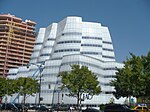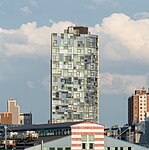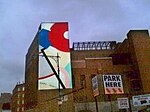Chambers Fine Art
Chambers Fine Art is an art gallery based in New York City and Beijing that specializes in Chinese contemporary art. Opened in New York in 2000 by Christophe Mao. Notable Chinese artists who had their first solo show in the United States at Chambers include: Lu Shengzhong, Shi Jinsong, Hong Hao, Qiu Zhijie, Hong Lei, and Chi Peng. In 2007 Chambers Fine Art opened a second 8,600-square-foot (800 m2) gallery-space designed by the artist, Ai Weiwei, in the Caochangdi district of Beijing. The inaugural exhibition Net: Reimagining Space, Time and Culture was organized by eminent Chinese art scholar, Wu Hung, and included works by Chinese contemporary artists Ai Weiwei, He Yunchang, Hong Hao, Hong Lei, Lu Shengzhong, Qiu Zhijie, Rong Rong & inri, Shi Jinsong, Song Dong, Wang Jianwei, Wang Tiande, Wu Jian’an, Yin Xiuzhen, Yu Hong, Guo Hongwei, Zhan Wang, Zhang Peili, Zheng Guogu. In October 2009, Chambers Fine Art moved its New York gallery to a 2,300-square-foot (210 m2) ground-floor space on 19th street in Chelsea's gallery district.
Excerpt from the Wikipedia article Chambers Fine Art (License: CC BY-SA 3.0, Authors).Chambers Fine Art
West 19th Street, New York Manhattan
Geographical coordinates (GPS) Address Nearby Places Show on map
Geographical coordinates (GPS)
| Latitude | Longitude |
|---|---|
| N 40.745732 ° | E -74.00716 ° |
Address
West 19th Street 520
10011 New York, Manhattan
New York, United States
Open on Google Maps





